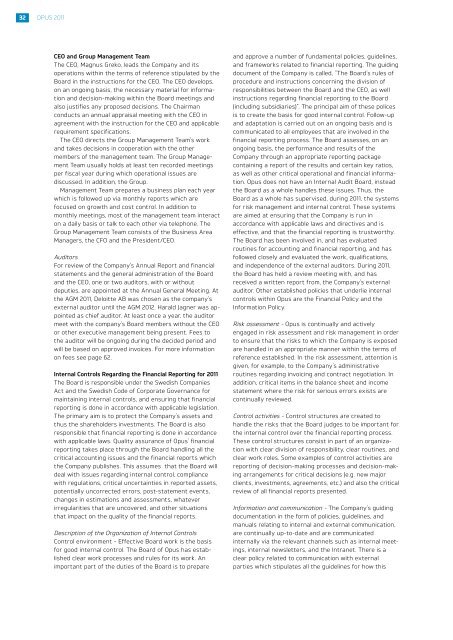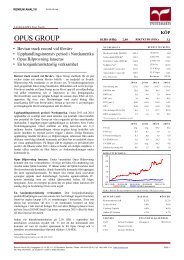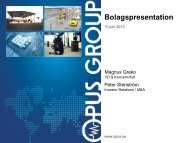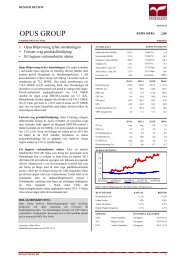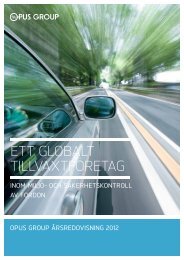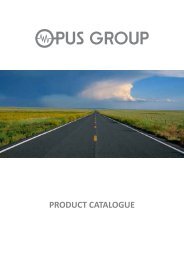Opus Group Annual 2011 Report ENG
Opus Group Annual 2011 Report ENG
Opus Group Annual 2011 Report ENG
You also want an ePaper? Increase the reach of your titles
YUMPU automatically turns print PDFs into web optimized ePapers that Google loves.
32<br />
OPUS <strong>2011</strong><br />
CEO and <strong>Group</strong> Management Team<br />
The CEO, Magnus Greko, leads the Company and its<br />
operations within the terms of reference stipulated by the<br />
Board in the instructions for the CEO. The CEO develops,<br />
on an ongoing basis, the necessary material for information<br />
and decision-making within the Board meetings and<br />
also justifies any proposed decisions. The Chairman<br />
conducts an annual appraisal meeting with the CEO in<br />
agreement with the instruction for the CEO and applicable<br />
requirement specifications.<br />
The CEO directs the <strong>Group</strong> Management Team’s work<br />
and takes decisions in cooperation with the other<br />
members of the management team. The <strong>Group</strong> Management<br />
Team usually holds at least ten recorded meetings<br />
per fiscal year during which operational issues are<br />
discussed. In addition, the <strong>Group</strong>.<br />
Management Team prepares a business plan each year<br />
which is followed up via monthly reports which are<br />
focused on growth and cost control. In addition to<br />
monthly meetings, most of the management team interact<br />
on a daily basis or talk to each other via telephone. The<br />
<strong>Group</strong> Management Team consists of the Business Area<br />
Managers, the CFO and the President/CEO.<br />
Auditors<br />
For review of the Company’s <strong>Annual</strong> <strong>Report</strong> and financial<br />
statements and the general administration of the Board<br />
and the CEO, one or two auditors, with or without<br />
deputies, are appointed at the <strong>Annual</strong> General Meeting. At<br />
the AGM <strong>2011</strong>, Deloitte AB was chosen as the company’s<br />
external auditor until the AGM 2012. Harald Jagner was appointed<br />
as chief auditor. At least once a year, the auditor<br />
meet with the company’s Board members without the CEO<br />
or other executive management being present. Fees to<br />
the auditor will be ongoing during the decided period and<br />
will be based on approved invoices. For more information<br />
on fees see page 62.<br />
Internal Controls Regarding the Financial <strong>Report</strong>ing for <strong>2011</strong><br />
The Board is responsible under the Swedish Companies<br />
Act and the Swedish Code of Corporate Governance for<br />
maintaining internal controls, and ensuring that financial<br />
reporting is done in accordance with applicable legislation.<br />
The primary aim is to protect the Company’s assets and<br />
thus the shareholders investments. The Board is also<br />
responsible that financial reporting is done in accordance<br />
with applicable laws. Quality assurance of <strong>Opus</strong>’ financial<br />
reporting takes place through the Board handling all the<br />
critical accounting issues and the financial reports which<br />
the Company publishes. This assumes that the Board will<br />
deal with issues regarding internal control, compliance<br />
with regulations, critical uncertainties in reported assets,<br />
potentially uncorrected errors, post-statement events,<br />
changes in estimations and assessments, whatever<br />
irregularities that are uncovered, and other situations<br />
that impact on the quality of the financial reports.<br />
Description of the Organization of Internal Controls<br />
Control environment - Effective Board work is the basis<br />
for good internal control. The Board of <strong>Opus</strong> has established<br />
clear work processes and rules for its work. An<br />
important part of the duties of the Board is to prepare<br />
and approve a number of fundamental policies, guidelines,<br />
and frameworks related to financial reporting. The guiding<br />
document of the Company is called, “The Board’s rules of<br />
procedure and instructions concerning the division of<br />
responsibilities between the Board and the CEO, as well<br />
instructions regarding financial reporting to the Board<br />
(including subsidiaries)”. The principal aim of these polices<br />
is to create the basis for good internal control. Follow-up<br />
and adaptation is carried out on an ongoing basis and is<br />
communicated to all employees that are involved in the<br />
financial reporting process. The Board assesses, on an<br />
ongoing basis, the performance and results of the<br />
Company through an appropriate reporting package<br />
containing a report of the results and certain key ratios,<br />
as well as other critical operational and financial information.<br />
<strong>Opus</strong> does not have an Internal Audit Board, instead<br />
the Board as a whole handles these issues. Thus, the<br />
Board as a whole has supervised, during <strong>2011</strong>, the systems<br />
for risk management and internal control. These systems<br />
are aimed at ensuring that the Company is run in<br />
accordance with applicable laws and directives and is<br />
effective, and that the financial reporting is trustworthy.<br />
The Board has been involved in, and has evaluated<br />
routines for accounting and financial reporting, and has<br />
followed closely and evaluated the work, qualifications,<br />
and independence of the external auditors. During <strong>2011</strong>,<br />
the Board has held a review meeting with, and has<br />
received a written report from, the Company’s external<br />
auditor. Other established policies that underlie internal<br />
controls within <strong>Opus</strong> are the Financial Policy and the<br />
Information Policy.<br />
Risk assessment - <strong>Opus</strong> is continually and actively<br />
engaged in risk assessment and risk management in order<br />
to ensure that the risks to which the Company is exposed<br />
are handled in an appropriate manner within the terms of<br />
reference established. In the risk assessment, attention is<br />
given, for example, to the Company’s administrative<br />
routines regarding invoicing and contract negotiation. In<br />
addition, critical items in the balance sheet and income<br />
statement where the risk for serious errors exists are<br />
continually reviewed.<br />
Control activities - Control structures are created to<br />
handle the risks that the Board judges to be important for<br />
the internal control over the financial reporting process.<br />
These control structures consist in part of an organization<br />
with clear division of responsibility, clear routines, and<br />
clear work roles. Some examples of control activities are<br />
reporting of decision-making processes and decision-making<br />
arrangements for critical decisions (e.g. new major<br />
clients, investments, agreements, etc.) and also the critical<br />
review of all financial reports presented.<br />
Information and communication - The Company’s guiding<br />
documentation in the form of policies, guidelines, and<br />
manuals relating to internal and external communication,<br />
are continually up-to-date and are communicated<br />
internally via the relevant channels such as internal meetings,<br />
internal newsletters, and the Intranet. There is a<br />
clear policy related to communication with external<br />
parties which stipulates all the guidelines for how this


